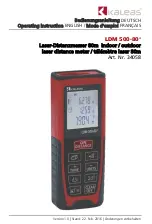
13
Inductors
Example: Determining the Inductance of a relatively small coil.
Process:
1. Plug the 50-ohm accessory connector into the Analyzer and clip the coil between the two test
leads.
2. Turn the Analyzer on and use the F5 softkey to scroll to the X screen. Enter 2 5 0 0 0 ENTER
to select an initial center frequency of 25 MHz. Press the WIDTH
p
key until the width is set
to 1 MHz. Also, use the F4 softkey to set the scale to the 0-250 ohms range.
3. Unless you select a higher frequency, low Reactance will probably cause the plot to flat line
near the bottom of the screen. If Inductance is relatively high in higher frequencies, the
Reactance plot will flat line near the top of the scale.
4. Experiment with different center frequency values until you find the point at which the
Reactance plot reaches approximately 50 ohms.
5. Use the F5 to scroll the Data screen. The Phase Angle (<:) should read approximately 45
°
. If
it does not, press the FREQ
p
or FREQ
q
key until it does. Now, identify the Inductance (L:)
value within the Data screen.
Capacitors
Example: Determining the Capacitance of a small capacitor (approximately 1000 pF).
Process:
1. Plug the 50-ohm accessory connector into the Analyzer, and clip the capacitor between the
two test leads.
2. Turn the Analyzer on, and use the F5 softkey to scroll to the X screen. Enter 5 0 0 0 ENTER
to select an initial center frequency of 5 MHz. Press the WIDTH
p
until the width is set to 1
MHz.
3. The Reactance plot will sweep down from the left side of the display, leveling out as it
approaches the right side.
4. Adjust the center frequency value until you determine the point at which the Reactance is
approximately 50 ohms.
5. Press F3 until the “Z:xxx X:xxx R:xxx <:xxx” data block is displayed. The Phase Angle (<:)
should read approximately 45
°
since the R and X values are roughly equal. If it does not,
adjust the center frequency until it reads as close to 45
°
as possible.
6. Press F3 to scroll to the “L:xxx C:xxx” data block. Refer to the “C:” value to determine
Capacitance.
TUNING ANTENNA TRAPS
Example: Using the 50-ohm accessory connector constructed for the above example to tune an
antenna trap (composed of a coil in parallel with a capacitor).
Process:
1. Leave the coil and capacitor of the trap connected at one end, separated at the other.
2. Clip one test lead of the accessory connector to the coil, the other test lead to the capacitor.
3. Turn the Analyzer on. Maintain the default S screen and plot values.
4. Determine on which side of the center frequency the bottom of the SWR curve rests. The
bottom of the curve should indicate the antenna’s resonant frequency.
5. To confirm the value of the resonant frequency, use F3 to scroll through the data blocks until
“MIN SWR:xxx at F:xxx” is displayed. This data block indicates the location of the minimum
SWR.
6. Press F5 to enter the Z screen. A “V” or “U”-shaped curve will appear, indicating the absolute
value if Impedance versus frequency.
7. Press F5 again to enter the X screen. The Reactance plot will dip down toward 0 ohms (on
the vertical scale) at the resonant frequency.
8. Refer to the analysis paragraphs following the “Tuning a Simple Antenna” procedure.
Summary of Contents for CIA-HF
Page 1: ...CIA HF Complex Impedance Analyzer Operating Manual ...
Page 24: ...21 ...












































